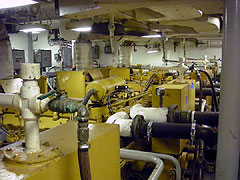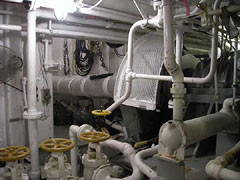

 | |||||||
|
|
Journals 2007/2008Heather Judkins
November 16, 2007 So, how are we moving around the ocean? I got a tour of the engine rooms and more of the McArthur II and it's like a secret world down on the bottom deck! I met with Jim or "JJ" to his friends, the chief engineer aboard the ship. He was kind enough to show me the basics of the engine room which I will try to explain here. We started in the control room which oversees the running of the 4 generators and the fire system. The Caterpillar generators each have 12 cylinders which use diesel fuel just like tractor trucks do on land. The ship can hold up to 278,000 gallons of fuel and each month of this cruise, they use about 60,000 gallons.  How do we have a continual freshwater source while surrounded by the ocean? The answer is that there are 2 evaporator systems that create our freshwater. There are 2 freshwater tanks, one of 1000 gallons which is a reserve tank and another that holds 4000 gallons which is the main tank used for all daily operations. Ocean water comes into the evaporator, into an eductor with a vacuum so water boils at 90 degrees F rather than 212 degrees. The water then moves through cooling plates and bromine is added as it moves into the main water tank. At this point, the water is distilled and ready to go! We use about 1500 gallons of freshwater per day for this type of cruise. I also had a chance to see the motors that propel the 2 props for the ship. The whole operation is run by diesel/electric power with 600 watts being made for the propulsion motors. There are two props which are each 6 feet across with 4 blades. Each motor for the propulsion system has 800 horsepower. The steering is conducted through a hydraulic system which allows the bridge to easily steer from the opposite end of the ship!  I also got a chance to see the A/C room, sewage area, and the layout of the ballast tanks on board. Overall, I was extremely impressed with the knowledge that JJ had as well as how the 5 engineers work to make sure the ship stays healthy! JJ has been out at sea with various projects since 1975 and has been a chief engineer since 1979. He has been with the McArthur II since 2000. The biggest challenge he thinks is the time away from his family and the most rewarding part of his job is having a vessel that runs smoothly while the projects are underway. Marine Science Questions: 1. How many gallons of diesel can a tractor trailer hold? 2. How many tractor trailer tanks does it take to fill the McArthur II? |
||||||